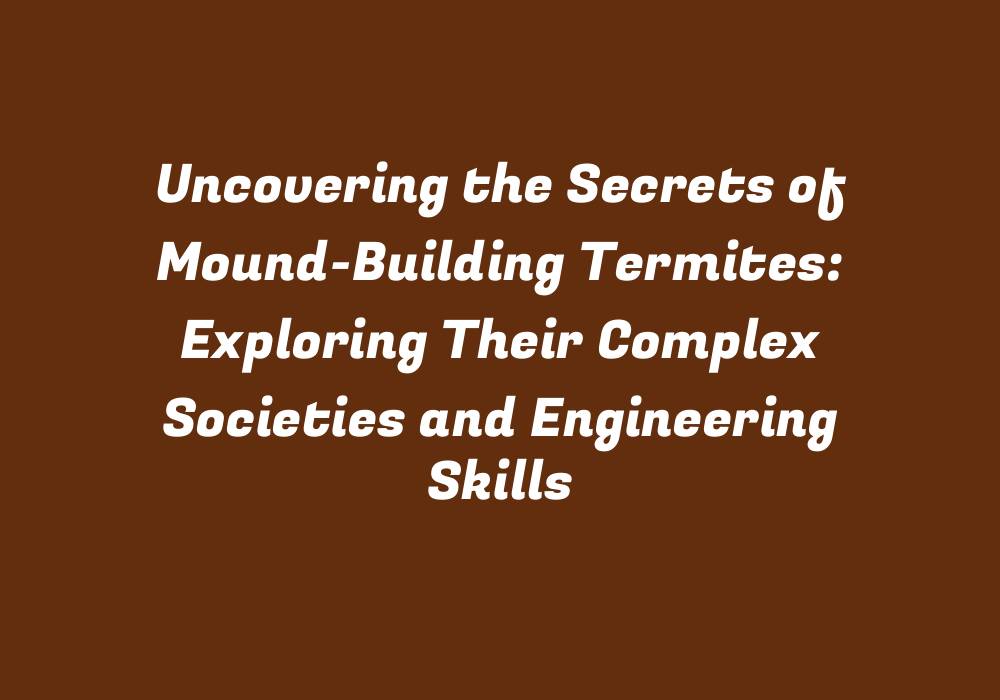Uncovering the Secrets of Mound-Building Termites: Exploring Their Complex Societies and Engineering Skills
Mound-building termites are a fascinating species within the world of insects, known for their extraordinary social behavior, engineering prowess, and unique habitat construction. This article aims to delve into the complex societies and impressive abilities of these remarkable creatures. We’ll explore various aspects of mound-building termite life including their societies, communication, and engineering skills that make them such a vital part of our ecosystem.
Social Behavior
Mound-building termites are highly social insects living in large colonies with various castes. These castes include the queen, king, workers, soldiers, and reproductives (alates). Each caste plays a distinct role within the colony, contributing to its overall functionality. For instance, queens serve as the primary egg-layers and ensure the continuation of the species. On the other hand, workers are responsible for foraging, building, caring for younger individuals, and defending their colonies.
Communication
Mound-building termites have developed an intricate system to communicate within their colony. Although they don’t possess sophisticated sensory organs like humans or other animals, they can detect changes in temperature, humidity, and the chemical composition of their environment. This information helps them coordinate activities with their fellow colony members.
Engineering Skills
Mound-building termites are known for their impressive engineering skills, which allow them to construct sophisticated mounds that serve as their homes and food sources. The mounds provide a stable environment that protects the colony from external threats, such as predators and adverse weather conditions. They also play an essential role in regulating temperature and humidity inside the nest.
Mound Construction
The process of building mounds begins with termites excavating soil and gathering organic materials like plant debris, feces, and saliva from their own bodies. They then mix these substances to create a mixture called cement. This cement is used as the foundation for their mounds. The termites will continue to expand and reinforce the structure using this cement mixture while simultaneously maintaining its shape.
Types of Mounds
There are several types of mound-building termite mounds, each with unique characteristics that cater to their specific needs. These include:
1. Domed or Central Mounds: This is the most common type of mound found in the wild, where the upper surface of the structure serves as a platform for the colony’s queen and reproductives. The outer edge of the dome provides protection from potential threats, while the interior is filled with chambers containing different castes within the colony.
2. Mushroom-Shaped Mounds: These mounds consist of a flat base that extends upwards to create a canopy-like structure, providing shade for the colony and sheltering them from direct sunlight. The upper part of these mounds is often enclosed with mud or leaves for additional protection against predators.
3. Chimney Mounds: This type of mound features an upward tunnel that leads to the outer surface, where termites can emerge for ventilation purposes while maintaining a stable temperature within the nest. The chimney-like structure also helps in dispersing excess humidity and heat from their colony.
Conclusion
Mound-building termites are remarkable creatures with complex societies, sophisticated communication systems, and impressive engineering skills. By understanding the various aspects of their behavior and lifestyle, we can appreciate their vital role in maintaining a healthy ecosystem and our environment. These fascinating insects continue to inspire researchers worldwide, shedding light on their unique abilities that help us better comprehend our natural world.
References
1. Mound-Building Termites: Engineering Marvels in the Insect World. (n.d.). Retrieved from https://www.livescience.com/61391-mound-building-termites-engineering-marvels-insect-world.html
2. Mound Building Termites: Their Social Structure, Behavior, and Engineering Capabilities. (n.d.). Retrieved from https://www.informativeessays.com/mound-building-termites/
3. The Amazing World of Mound-Building Termites. (n.d.). Retrieved from https://science.howstuffworks.com/environmental/life/animals/the-amazing-world-of-mound-building-termite1.htm
4. Termite Architects: Engineering Marvels in the Natural World. (n.d.). Retrieved from https://www.britannica.com/story/termites-engineering-marvels-in-the-natural-world
